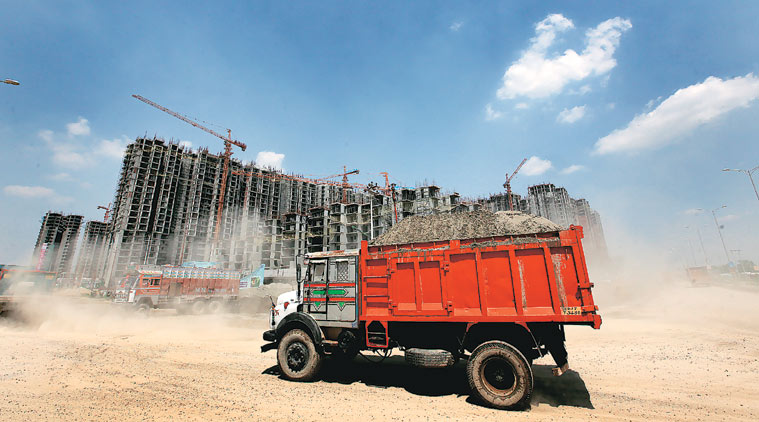- India
- International
Death by Breath: Why building dust is lethal mix
Cement manufacturing, which involves burning of coal and limestone at very high temperatures, contributes to seven per cent of carbon dioxide emissions globally.
 At a site at Noida Extension. Note the uncovered material, the uncovered scaffolds and the absence of a vegetation buffer. (Source: Express photo by Ravi Kanojia)
At a site at Noida Extension. Note the uncovered material, the uncovered scaffolds and the absence of a vegetation buffer. (Source: Express photo by Ravi Kanojia)The construction dust that envelops a construction site is a lethal cocktail of excavated soil, materials like cement, asbestos, plaster, silica, synthetic fibres, metal dust and paint fumes.
Dr Shashank Bishnoi, assistant professor in civil engineering from IIT Delhi who is working on a project with IITs Bombay and Madras to make the environmentally sustainable LC3 cement, said majority of these particles are of the bigger particulate matter size.
“At every stage, construction contributes to particulates up to 10 microns we see in the atmosphere. Be it production of materials like cement extensively used in construction in India or excavation at construction sites like flyovers, soil that was bound is dug and converted to loose soil which is carried by wind. Then there is transportation of materials like concrete, sand and fly ash which are again scattered in the wind,” Bishnoi said.
[related-post]
Cement manufacturing, which involves burning of coal and limestone at very high temperatures, contributes to seven per cent of carbon dioxide emissions globally.
Bishnoi said as part of an ongoing project sponsored by the Swiss embassy, they have produced about 160-70 tonnes of low carbon and low energy cement.

“Globally, cement has been recognised as the most polluting material in the world. Portland cement, which is the most commonly used cement in India, is used in all construction materials like concrete and mortar. It uses 70 per cent of what are known as clinkers and 25-27 per cent of fly ash which is waste from coal burning. We are trying to reduce this clinker content to 30-40 per cent which will reduce the health impact and also be more environmentally sustainable,” he said.
Experts who have conducted visits to NCR construction sites say respiratory and skin diseases are the most common due to sustained exposure to cement.
Dr Shubhendu Mudgal, occupational health expert who has performed environmental impact assessments for construction sites in Delhi NCR for over 15 years, said: “I particularly remember that at two major construction sites, where cement was used extensively, respiratory diseases like bronchitis were common. Cement particles enter the upper parts of the lung which, over a long period of exposure, leads to conditions like chronic obstructive pulmonary disease (COPD) or severe shortness of breath, a condition which is multifactorial as it is also attributed to smoking.”
A study on construction workers in Tamil Nadu in cement industry units by the Indian Council of Medical Research’s Ahmedabad-based National Institute of Occupational Health (NIOH) found asthma, bronchitis and sinusitis between 17 to 23 per cent among workers in 2013. A similar study in Kolkata found 20 per cent restrictive and obstructive respiratory diseases from cement exposure.
Dr T K Joshi, director of Centre for Occupational and Environmental Medicine at Delhi’s Maulana Azad Medical College, said: “Portland cement is caustic and absorbs moisture and is touched directly by workers who wear no protective gloves. This leads to inflammation and reddening of skin, and burning, a condition called cement dermatitis. This cement also contains traces of chromium which leads to allergic respiratory reactions in workers.”
Asbestos which is banned in countries of Europe and Canada for being a health hazard continues to be exported and extensively used in India in construction materials. “Asbestos inhalation leads to fibrosis or shrinking of lung capacity, which eventually causes a condition called pneumoconiosis which restricts respiratory activity. Asbestos inhalation most commonly causes an occupational disease called asbestosis where lung capacity is reduced. This leads to inflammation of tissues lining the lung, and contributes to increased risk of lung cancer,” Joshi said.
The NIOH estimates that the total use of asbestos in India is 1.25 lakh tonnes, of which more than 1 lakh tonnes is being imported. The NIOH carried out epidemiological studies in four of 18 asbestos cement factories — in Ahmedabad, Hyderabad, Coimbatore and Mumbai. It found the prevalence of asbestosis varying from 3 per cent to 5 per cent, higher than the permissible level of 2 fibres/ml in India and much higher than the internationally accepted limit of 0.1 fibres/ml.
Silica which has finer particles less than 2.5 microns leads to irreversible fibrosis or scarring of the lungs, and adds to the risk of tuberculosis. “While the bigger PM 10 particles are restricted to the upper respiratory tract, silica produces very fine dust which can penetrate to the deepest parts of the lungs and lower respiratory tract. The inflammation cause by inhaling silica leads to silicosis which is recognised by the International Labour Organisation (ILO) as the most common respiratory occupational disease where lung capacity is reduced, and there is shortness of breath and bluing of skin with risk of lung cancers,” Joshi said.
“Inhalation of fine silica dust is also the reason we see increased risk of tuberculosis in construction workers. But everywhere you find employers blaming smoking habits and poor nutrition levels, so tuberculosis is not recognised as an occupational disease,” Mudgal said.
Health hazard awareness among construction employers is very poor. “There is little or no effort by employers, including government and private industrialists, to check dust accumulation at construction sites. Poor workers have always been the first casualties of sustained exposure to this cocktail, so the specialty of occupational medicine has as such not received much attention,” Mudgal said.
Experts say the realm of para occupational diseases also needs recognition. “A worker at a construction site does not change clothes or wash up before eating. He goes home in clothes covered in silica or cement dust and passes them at home. Recently, we had a woman who had a very specific lung cancer associated with silica but had never visited a construction site. Then we realised her husband had worked in the construction sector for three-four decades,”Joshi said.
Apr 25: Latest News
- 01
- 02
- 03
- 04
- 05








































